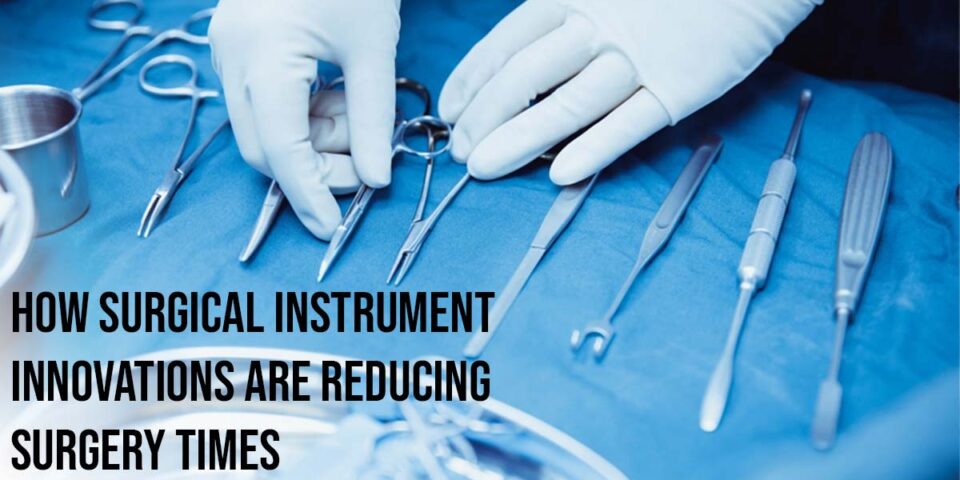How Surgical Instrument Innovations Are Reducing Surgery Times
Efficiency and accuracy are the most important requirements in an operating room. Every minute counts and much has changed in improving surgical tools for surgery leading to rapid surgeries, excellent outcomes, and processes in health care. Here’s how high-tech surgical equipment today is changing the surgery scene towards better speed, safety, and efficiency.
1. Customized Instruments For Speedy Surgeries
New generation surgical instruments are precision engineered to enhance accuracy while minimizing the efforts for the surgeons. The tools, like the robotic-assisted surgical tools, are made to function with extreme precision so that it lets the surgeons make complex maneuvers with minimal margin for error. For instance, the minimally invasive ones that allow smaller incisions lead to faster access to the surgical site with less tissue disruption. Thus these instruments speed up procedures and reduce the risk of complications leading to a quick recovery.
2. Automation In The Or
Automation has been successful in entering the OR to optimize time spent on repetitive or time-consuming tasks. For instance, a robotic arm can be programmed to stitch, cut, and staple tissues with precise consistency. Thus, these automated systems reduce the need for manual intervention so that a surgeon can concentrate more on critical aspects of the procedure. On the other hand, robotic systems afford steadiness, thus creating sharp incisions that are decreasing the time spent operating and so decreasing human error. Surgical instruments manufacturers in Chennai are at the forefront of providing automated instruments that improve efficiency.
3. Visualization Advances For Decision Making
Seeing anatomy in surgery is as important as cutting it precisely. Advanced visualization tools allow surgeons to see the internal parts of the body more prominently with the help of 3D cameras, augmented reality glasses, and others. Surgeons avoid prolonged exploratory surgery procedures due to their knowledge of the complexities of anatomy. High-definition imaging and 3D models ensure that surgeons quickly diagnose the problem at hand, visualizing challenges that might come up, thus allowing them to operate with unparalleled clarity, further improving speed and accuracy.
4. Disposable Instruments: Reduced Preparation And Decontamination
Disposable surgical instruments eliminate much prep and decontamination time. Reusables require sterilization between cases-an activity in itself. This means savings between patients in preserving flow, which is especially advantageous in high-volume environments. Infection rates are also minimized by disposable instruments, thus improving patient outcomes. Many surgical instruments suppliers now prioritize disposable options to improve procedural efficiency and safety.
5. Energy-Based Devices For Rapid And Safe Treatment
Another innovation, which hastened the surgical process, is energy-based surgical devices such as ultrasonic scalpels and electrosurgical units. Such instruments cut and coagulate simultaneously by applying energy thus minimizing tool-changing during a procedure. The ability to make rapid incisions with minimum blood loss reduces the chances of postoperative complications. Energy-based devices, therefore, bring surgeries nearer to becoming shorter and more efficient and completing several functions in one step.
6. Real-Time Feedback Smart Instruments
Sensitized and feedback-equipped smart surgical instruments take the efficiency to whole new levels. Sensor equipping and integration in surgical instrumentation offer surgeons the valuable real-time data they can act on, to their advantage, at the moment. In this regard, sensor-equipped instruments would be able to inform a surgeon if a high pressure is being applied on the lesion site or in case of tissue resistance. This immediate feedback enables the prompt correction that ultimately accelerates the process and is made safely.
Continuous innovation is the future of surgery. Today, with the development and evolution of surgical instruments, more patients are treated in a shorter amount of time, making health care accessible and satisfactory for the patients. With the advancement of technology, surgical tools will be more precise, intelligent, and efficient, thus opening a new chapter in the medical world where speed and accuracy go hand in hand. These innovations transform surgeries, not only in cutting time but also increasing the standard of care.
Surgical instrument innovations are rapidly improving the quality and efficiency of modern healthcare. These inventions help cut surgery time, which makes the procedure easier and bearable while having a lasting beneficial impact on patients’ lives.

